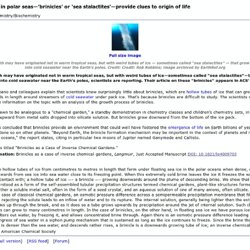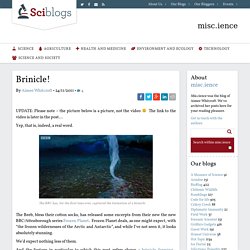

Sea-Ice Brinicles As Spires of Life. What's cooler than being cool?

Brine-cold. When salt-rich water leaks out of sea ice, it sinks into the sea and can occasionally create an eerie finger of ice called a brinicle. New research explains how these strange fingers of ice form and how the salty water within sea ice could have been a prime environment in which life may have evolved. The study, published in the American Chemical Society's journal Langmuir, suggests that brinicles form in the same way as hydrothermal vents, except in reverse. Hydrothermal vents are spiny-looking towers on the ocean bottom where boiling, chemical-rich water flows out of the seafloor. Celebrating randomness: bioluminescent dinoflagellates (or awesome glowing water!)
I got to play with bioluminescence this weekend!

Some friends invited me out on a short kayak trip and we able to experience the magical glowing water firsthand! But, of course, it wasn't magic... it was science! Bioluminescence is the production and emission of light by a living organism. The name comes from the Greek word bios for “living” and the Latin word lumen for “light.” So, put it together and you have “living lights"! I've heard about this phenomenon in Puerto Rico. There is also some incredible footage of luminescent algae (dinoflagellate) blooms in Southern California, where the waves appear to glow! But little did I know this also occurred right here in northern California in Tomales Bay! In the daylight, we saw pelicans, sea jellies, seals, and even a bat ray! Why only those dates? According to the Vieques site, the best time to observe the bioluminesence aligns with particular phases of the moon, between full and new moon, to be exact.
What's making all the glow? Yep. Video of the day: Beautiful "brinicle" in Antarctica. BBC/Frozen Planet Ever heard of a brinicle?

Nor had we - until we stumbled upon this video, which shows a bizarre 'icicle of death' forming underwater in Antarctica. Scroll down for video. Using time-lapse cameras, BBC filmakers Doug Anderson and Hugh Miller captured images of this amazing phemomenon for the first time in history. Brinicles are webs of ice that freeze everything they touch - including living things such as sea urchins and starfish. This video was taken from BBC1's series, Frozen Planet Related articles Scotland's underwater wonderland.
Brinicles and the Origin of Life. Ice tubes in polar seas—'brinicles' or 'sea stalactites'—provide clues to origin of life. Apr 24, Chemistry/Biochemistry Life on Earth may have originated not in warm tropical seas, but with weird tubes of ice — sometimes called “sea stalactites” — that grow downward into cold seawater near the Earth's poles.

Credit: Credit: Rob Robbins; image archived by EarthRef.org. Life Could Have Evolved in Frigid Underwater Ice Gardens : Visual Science. New evidence indicates that chemical gardens which form beneath the Antarctic ice could be the origin of coldwater life.

Brinicles, first captured forming on film by the BBC in 2011, are hollow tubes of ice that descend from Antarctic sea ice. They look a lot like icicles, but aren’t. As sea water freezes into ice, it excludes salt and other ions, which get trapped in brine-rich compartments in sea ice. Video of the day: Beautiful "brinicle" in Antarctica. Sea-Ice Brinicles As Spires of Life. "Brinicle" - an underwater "icicle of death" YouTube link .

Filmed "beneath the ice off the foothills of the volcano Mount Erebus", the timelapse covers a period of 4-5 hours; here's some of the relevant science (from the YouTube link): In winter, the air temperature above the sea ice can be below -20C, whereas the sea water is only about -1.9C. Heat flows from the warmer sea up to the very cold air, forming new ice from the bottom. The salt in this newly formed ice is concentrated and pushed into the brine channels. And because it is very cold and salty, it is denser than the water beneath. Frozen Planet: Capturing the Brinicle. Brinicle. UPDATE: Please note – the picture below is a picture, not the video The link to the video is later in the post… Yep, that is, indeed, a real word.

Ice tube 'brinicles' may conceal origins of life. Ice tube ‘brinicles’ may conceal origins of life April 24th, 2013 | Published in Arctic Ocean, Science, The Southern Ocean | 2 Comments A brinicle forms in Antarctica.

How Brinicles Form. What's cooler than being cool?

Brine-cold. When salt-rich water leaks out of sea ice, it sinks into the sea and can occasionally create an eerie finger of ice called a brinicle. Frozen Planet: Capturing the Brinicle. Provide clues to origin of life. Life on Earth may have originated not in warm tropical seas, but with weird tubes of ice -- sometimes called "sea stalactites" -- that grow downward into cold seawater near Earth's poles, scientists are reporting.

Their article on these "brinicles" appears in ACS' journal Langmuir. Bruno Escribano and colleagues explain that scientists know surprisingly little about brinicles, which are hollow tubes of ice that can grow to several yards in length around streamers of cold seawater under pack ice. That's because brinicles are difficult to study. The scientists set out to gather more information on the topic with an analysis of the growth process of brinicles. They are shown to be analogous to a "chemical garden," a standby demonstration in chemistry classes and children's chemistry sets, in which tubes grow upward from metal salts dropped into silicate solution. ‘Brinicle’ ice finger of death. Watch video on BBC’s website A bizarre underwater “icicle of death” has been filmed by a BBC crew.
With timelapse cameras, specialists recorded salt water being excluded from the sea ice and sinking. The temperature of this sinking brine, which was well below 0C, caused the water to freeze in an icy sheath around it. Where the so-called “brinicle” met the sea bed, a web of ice formed that froze everything it touched, including sea urchins and starfish.
The unusual phenomenon was filmed for the first time by cameramen Hugh Miller and Doug Anderson for the BBC One series Frozen Planet. Creeping Ice How Does a Brinicle Form? Dr Mark Brandon Polar oceanographer, The Open University. ‘Brinicle’ ice finger of death. Frozen Planet: Capturing the Brinicle.